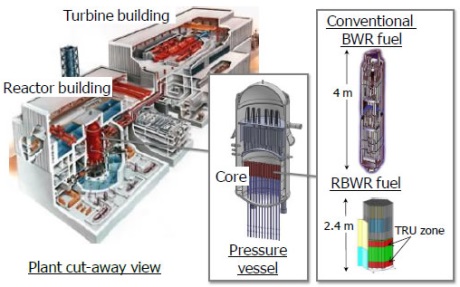Hitachi collaborates on TRU-consuming reactor development
29 August 2014
Japan's Hitachi has begun further joint research with three US universities into the development of reactors that could use transuranic (TRU) elements as fuel. This could result in a significant decrease in the time needed for the decay in the radioactivity of used fuel.
TRU elements are man-made elements that are heavier than uranium formed in nuclear fuel as a result of the fission process. The main transuranic constituents of used fuel are isotopes of plutonium, curium, neptunium and americium which are alpha-emitters and have long half-lives, decaying on a similar time scale to the uranium isotopes. They are the reason why used fuel needs secure disposal beyond the few thousand years or so which might be necessary for the decay of fission products alone.
 |
| Hitachi's concept for the RBWR |
Hitachi has been working on the development of resource-renewable boiling water reactors (RBWRs) based on existing boiling water reactor (BWR) technology. These RBWRs have the potential to use TRUs separated and refined from used nuclear fuel as fuel along with uranium. According to Hitachi, "If TRUs can be effectively removed from these used fuels, then the period of decay for the remaining radioactive waste materials could be reduced to just a few hundred years."
The difference between RBWRs and BWRs is in the design of the fuel assemblies and control rods. The fuel assemblies are much shorter for the RBWR, while the control rod is Y-shaped to be compatible with the hexagonal fuel assembly. The fuel is packed in more tightly in the RBWR to reduce the moderating effect of the water. This reduced moderation means that more fissile plutonium is produced and the breeding ratio is around 1 (instead of about 0.6), and much more of the uranium-238 is converted to plutonium-239 and then burned than in a conventional reactor.
The company conducted joint research targeting RBWRs with Massachusetts Institute of Technology (MIT), the University of Michigan (U-M) and the University of California at Berkeley (UCB) between 2007 and 2011. This research evaluated the safety and performance in the burning of TRUs.
Hitachi has now started a new stage of joint research with the three US universities. The company said, "Through this joint research, Hitachi plans to evaluate the performance and safety of RBWRs ... and to study plans for testing with a view toward practical applications with each university."
Although RBWRs use new core fuel concepts to burn TRUs, they use the same non-core components as current BWRs, including safety systems and turbines. Hitachi suggests that these RBWR fuel cores could fit within the pressure vessel of its already commercial Advanced Boiling Water Reactors (ABWR). It said, "RBWRs are unique in that extensive experience accumulated through the application of BWRs can be leveraged to achieve efficient nuclear fission in TRUs."
Researched and written
by World Nuclear News